Page 22 of 241
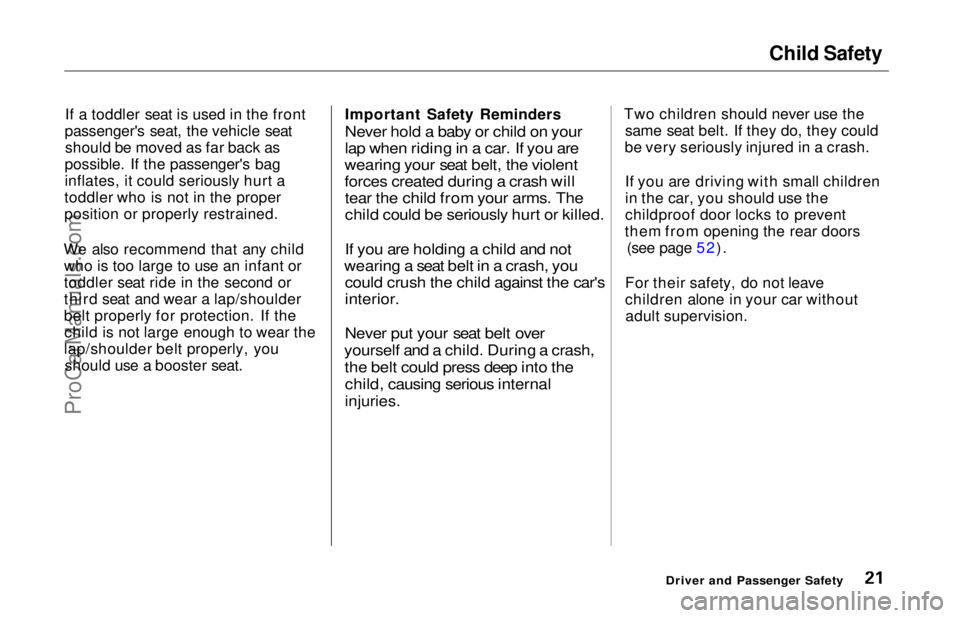
Child Safety
If a toddler seat is used in the front
passenger's seat, the vehicle seat should be moved as far back as
possible. If the passenger's bag
inflates, it could seriously hurt a
toddler who is not in the proper
position or properly restrained.
We also recommend that any child who is too large to use an infant or
toddler seat ride in the second or
third seat and wear a lap/shoulder
belt properly for protection. If thechild is not large enough to wear the
lap/shoulder belt properly, you should use a booster seat. Important Safety Reminders
Never hold a baby or child on your
lap when riding in a car. If you are
wearing your seat belt, the violent
forces created during a crash will tear the child from your arms. The
child could be seriously hurt or killed.
If you are holding a child and not
wearing a seat belt in a crash, you could crush the child against the car's
interior.
Never put your seat belt over
yourself and a child. During a crash, the belt could press deep into thechild, causing serious internal
injuries.
Two children should never use the
same seat belt. If they do, they could
be very seriously injured in a crash.
If you are driving with small children
in the car, you should use the
childproof door locks to prevent
them from opening the rear doors (see page 52).
For their safety, do not leave
children alone in your car without adult supervision.
Driver and Passenger SafetyProCarManuals.comMain Menu Table of Contents s t
Page 23 of 241
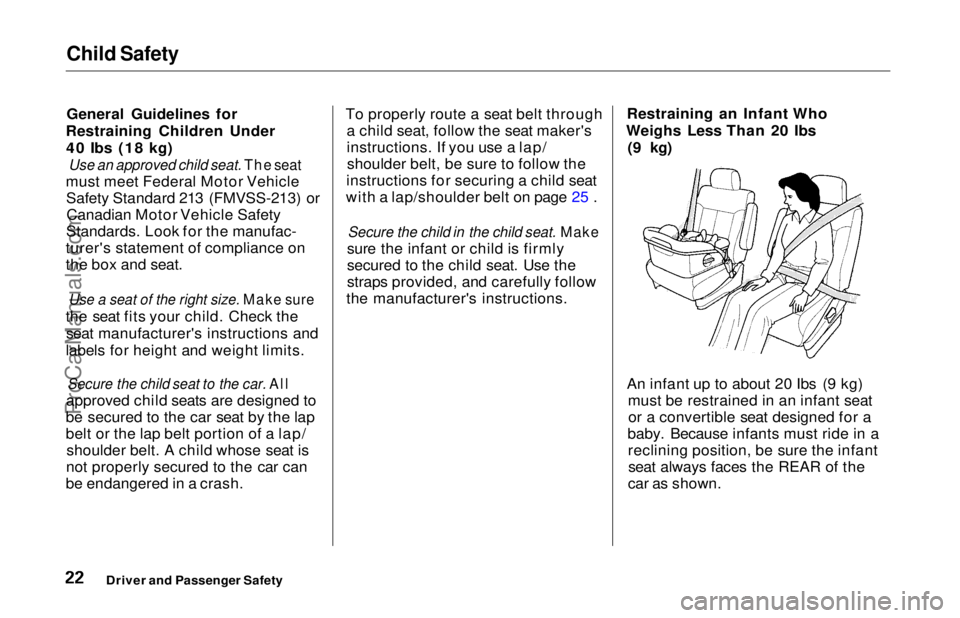
Child Safety
General Guidelines for
Restraining Children Under 40 Ibs (18 kg)
Use an approved child seat. The seat
must meet Federal Motor Vehicle Safety Standard 213 (FMVSS-213) orCanadian Motor Vehicle Safety
Standards. Look for the manufac-
turer's statement of compliance on
the box and seat.
Use a seat of the right size. Make sure
the seat fits your child. Check the seat manufacturer's instructions and
labels for height and weight limits.
Secure the child seat to the car. All
approved child seats are designed to
be secured to the car seat by the lap
belt or the lap belt portion of a lap/ shoulder belt. A child whose seat is
not properly secured to the car can
be endangered in a crash. To properly route a seat belt through
a child seat, follow the seat maker's
instructions. If you use a lap/shoulder belt, be sure to follow the
instructions for securing a child seat
with a lap/shoulder belt on page 25 .
Secure the child in the child seat. Make
sure the infant or child is firmly
secured to the child seat. Use the
straps provided, and carefully follow
the manufacturer's instructions. Restraining an Infant Who
Weighs Less Than 20 Ibs (9 kg)
An infant up to about 20 Ibs (9 kg) must be restrained in an infant seator a convertible seat designed for a
baby. Because infants must ride in a reclining position, be sure the infantseat always faces the REAR of the
car as shown.
Driver and Passenger SafetyProCarManuals.comMain Menu Table of Contents s t
Page 24 of 241
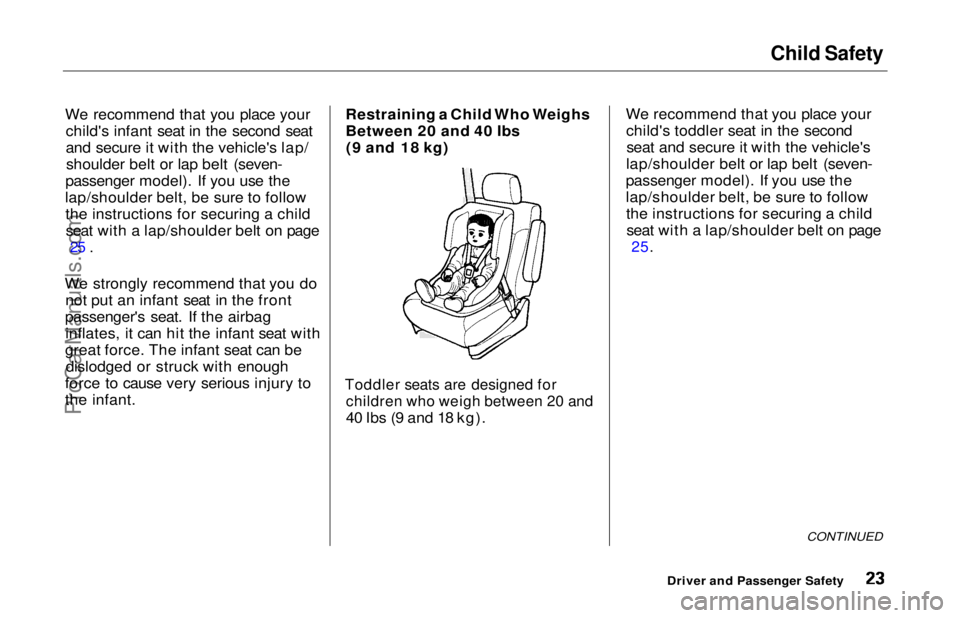
Child Safety
We recommend that you place your child's infant seat in the second seat
and secure it with the vehicle's lap/shoulder belt or lap belt (seven-
passenger model). If you use the
lap/shoulder belt, be sure to follow the instructions for securing a childseat with a lap/shoulder belt on page
25 .
We strongly recommend that you do not put an infant seat in the front
passenger's seat. If the airbag inflates, it can hit the infant seat with
great force. The infant seat can be dislodged or struck with enough
force to cause very serious injury to
the infant. Restraining a Child Who Weighs
Between 20 and 40 Ibs
(9 and 18 kg)
Toddler seats are designed for
children who weigh between 20 and
40 Ibs (9 and 18 kg). We recommend that you place your
child's toddler seat in the secondseat and secure it with the vehicle's
lap/shoulder belt or lap belt (seven-
passenger model). If you use the
lap/shoulder belt, be sure to follow the instructions for securing a childseat with a lap/shoulder belt on page
25.
CONTINUED
Driver and Passenger SafetyProCarManuals.comMain Menu Table of Contents s t
Page 25 of 241
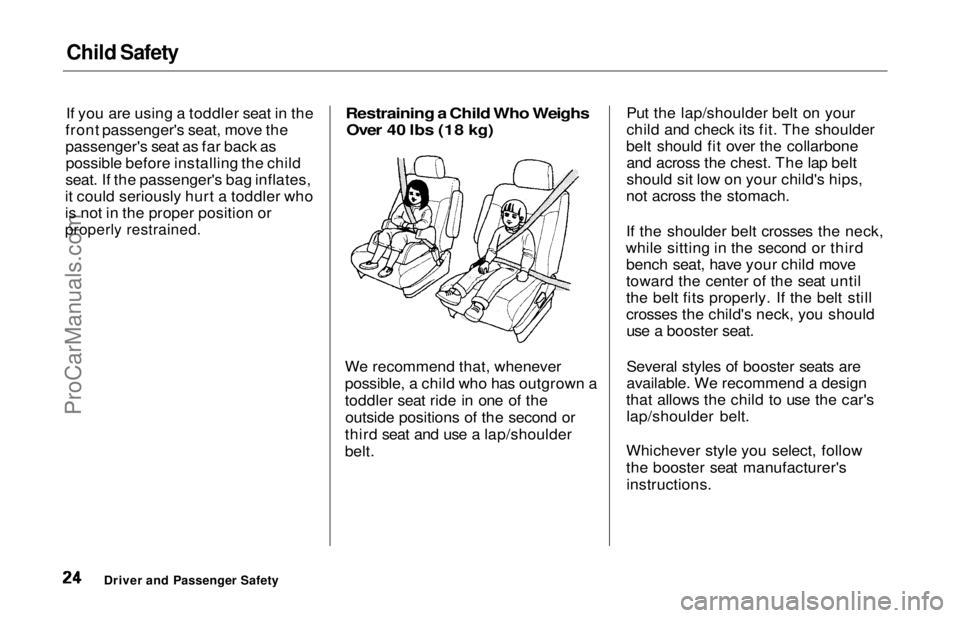
Child Safety
If you are using a toddler seat in the
front passenger's seat, move the
passenger's seat as far back as possible before installing the child
seat. If the passenger's bag inflates,
it could seriously hurt a toddler who
is not in the proper position or
properly restrained.
Restraining a Child Who Weighs
Over 40 lbs (18 kg)
We recommend that, whenever
possible, a child who has outgrown a
toddler seat ride in one of the outside positions of the second or
third seat and use a lap/shoulder
belt. Put the lap/shoulder belt on your
child and check its fit. The shoulder
belt should fit over the collarbone and across the chest. The lap belt
should sit low on your child's hips,
not across the stomach.
If the shoulder belt crosses the neck,
while sitting in the second or third bench seat, have your child move
toward the center of the seat until
the belt fits properly. If the belt still
crosses the child's neck, you shoulduse a booster seat.
Several styles of booster seats are
available. We recommend a design
that allows the child to use the car's lap/shoulder belt.
Whichever style you select, follow
the booster seat manufacturer's instructions.
Driver and Passenger SafetyProCarManuals.comMain Menu Table of Contents s t
Page 26 of 241
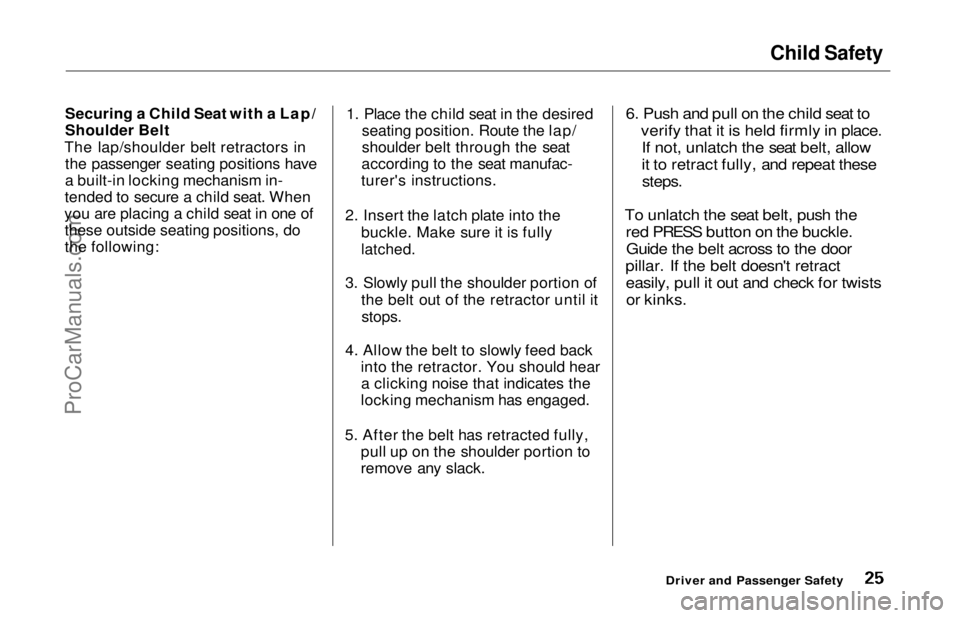
Child Safety
Securing a Child Seat with a Lap/
Shoulder Belt
The lap/shoulder belt retractors in the passenger seating positions have
a built-in locking mechanism in-
tended to secure a child seat. When
you are placing a child seat in one of these outside seating positions, do
the following: 1. Place the child seat in the desired
seating position. Route the lap/
shoulder belt through the seat
according to the seat manufac-
turer's instructions.
2. Insert the latch plate into the buckle. Make sure it is fully
latched.
3. Slowly pull the shoulder portion of the belt out of the retractor until it
stops.
4. Allow the belt to slowly feed back into the retractor. You should heara clicking noise that indicates the
locking mechanism has engaged.
5. After the belt has retracted fully, pull up on the shoulder portion to
remove any slack.
6. Push and pull on the child seat to
verify that it is held firmly in place.If not, unlatch the seat belt, allow
it to retract fully, and repeat these
steps.
To unlatch the seat belt, push the red PRESS button on the buckle.Guide the belt across to the door
pillar. If the belt doesn't retract easily, pull it out and check for twistsor kinks.
Driver and Passenger SafetyProCarManuals.comMain Menu Table of Contents s t
Page 27 of 241
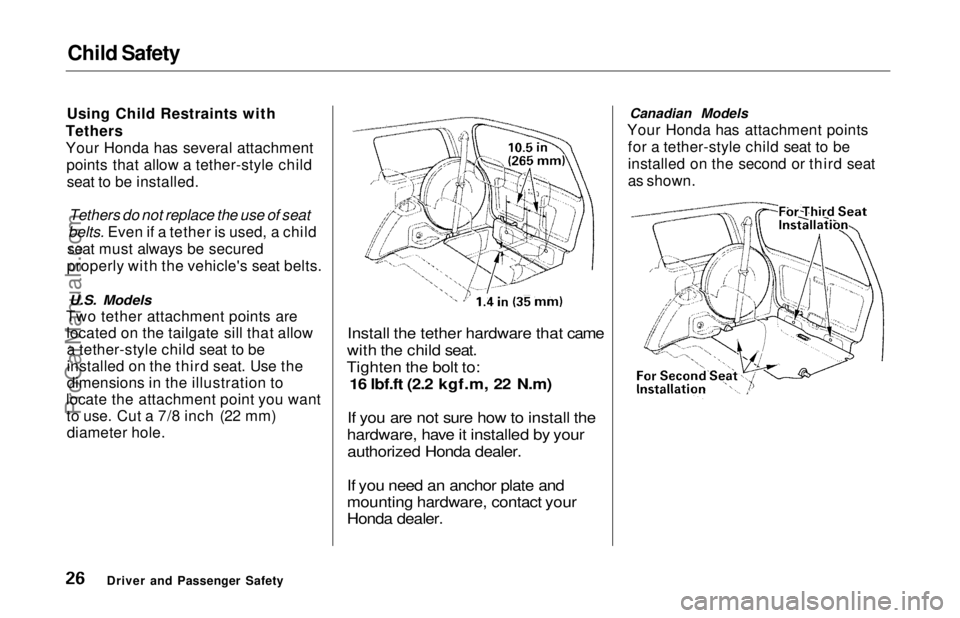
Child Safety
Using Child Restraints with
Tethers
Your Honda has several attachment points that allow a tether-style childseat to be installed.
Tethers do not replace the use of seat
belts. Even if a tether is used, a child
seat must always be secured
properly with the vehicle's seat belts.
U.S. Models
Two tether attachment points are located on the tailgate sill that allowa tether-style child seat to be
installed on the third seat. Use the
dimensions in the illustration to
locate the attachment point you want to use. Cut a 7/8 inch (22 mm)diameter hole.
Install the tether hardware that came
with the child seat.
Tighten the bolt to: 16 lbf.ft (2.2 kgf.m, 22 N.m)
If you are not sure how to install the
hardware, have it installed by your authorized Honda dealer.
If you need an anchor plate and
mounting hardware, contact your
Honda dealer.
Canadian Models
Your Honda has attachment points for a tether-style child seat to be
installed on the second or third seat
as shown.
Driver and Passenger SafetyProCarManuals.comMain Menu Table of Contents s t
Page 34 of 241
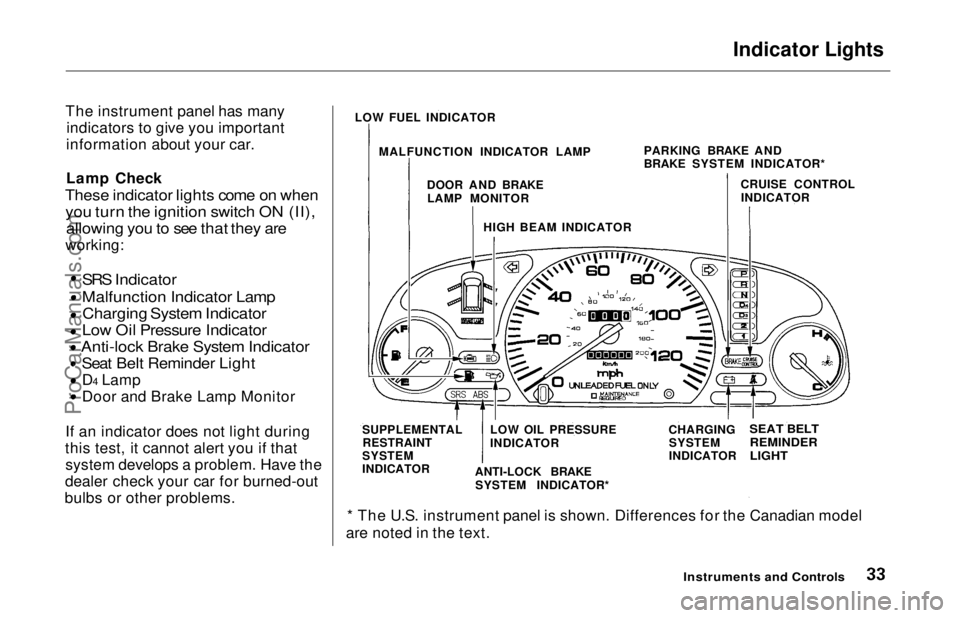
Indicator Lights
The instrument panel has many indicators to give you important
information about your car.
Lamp Check
These indicator lights come on when
you turn the ignition switch ON (II),
allowing you to see that they are
working:
SRS Indicator
Malfunction Indicator Lamp
Charging System Indicator
Low Oil Pressure Indicator
Anti-lock Brake System Indicator
Seat Belt Reminder Light
D4 Lamp
Door and Brake Lamp Monitor
If an indicator does not light during
this test, it cannot alert you if that system develops a problem. Have the
dealer check your car for burned-out
bulbs or other problems.
* The U.S. instrument panel is shown. Differences for the Canadian model
are noted in the text.
Instruments and Controls
LOW FUEL INDICATOR
MALFUNCTION INDICATOR LAMP DOOR AND BRAKELAMP MONITOR
HIGH BEAM INDICATOR PARKING BRAKE AND
BRAKE SYSTEM INDICATOR*
CRUISE CONTROLINDICATOR
SUPPLEMENTAL RESTRAINT
SYSTEM
INDICATOR LOW OIL PRESSURE
INDICATOR
ANTI-LOCK BRAKE SYSTEM INDICATOR* CHARGING
SYSTEM
INDICATOR
SEAT BELT
REMINDER
LIGHTProCarManuals.comMain Menu Table of Contents s t
Page 35 of 241
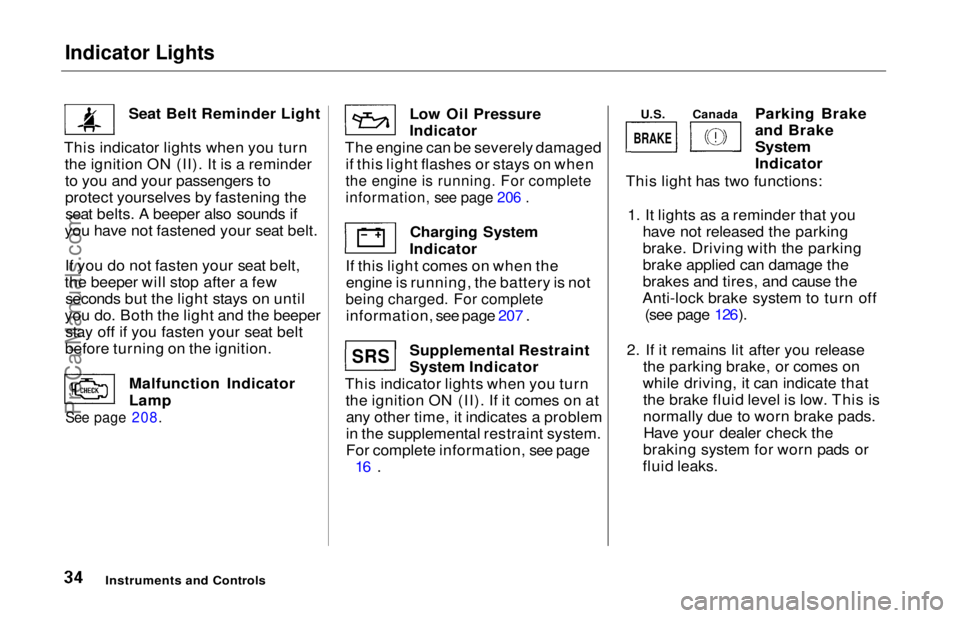
Indicator Lights
Seat Belt Reminder Light
This indicator lights when you turn the ignition ON (II). It is a reminderto you and your passengers to
protect yourselves by fastening theseat belts. A beeper also sounds if
you have not fastened your seat belt.
If you do not fasten your seat belt,
the beeper will stop after a few seconds but the light stays on until
you do. Both the light and the beeper stay off if you fasten your seat belt
before turning on the ignition.
Malfunction Indicator
Lamp
See page 208.
Low Oil Pressure
Indicator
The engine can be severely damaged if this light flashes or stays on when
the engine is running. For complete
information, see page 206 .
Charging System
Indicator
If this light comes on when the engine is running, the battery is not
being charged. For complete
information, see page 207 .
Supplemental Restraint
System Indicator
This indicator lights when you turn the ignition ON (II). If it comes on atany other time, it indicates a problem
in the supplemental restraint system.
For complete information, see page 16 . Parking Brake
and Brake
System
Indicator
This light has two functions:
1. It lights as a reminder that you have not released the parking
brake. Driving with the parking
brake applied can damage the
brakes and tires, and cause the
Anti-lock brake system to turn off (see page 126).
2. If it remains lit after you release the parking brake, or comes on
while driving, it can indicate that the brake fluid level is low. This is
normally due to worn brake pads.Have your dealer check the
braking system for worn pads or
fluid leaks.
Instruments and Controls
U.S.
Canada
SRS
BRAKE
ProCarManuals.comMain Menu Table of Contents s t